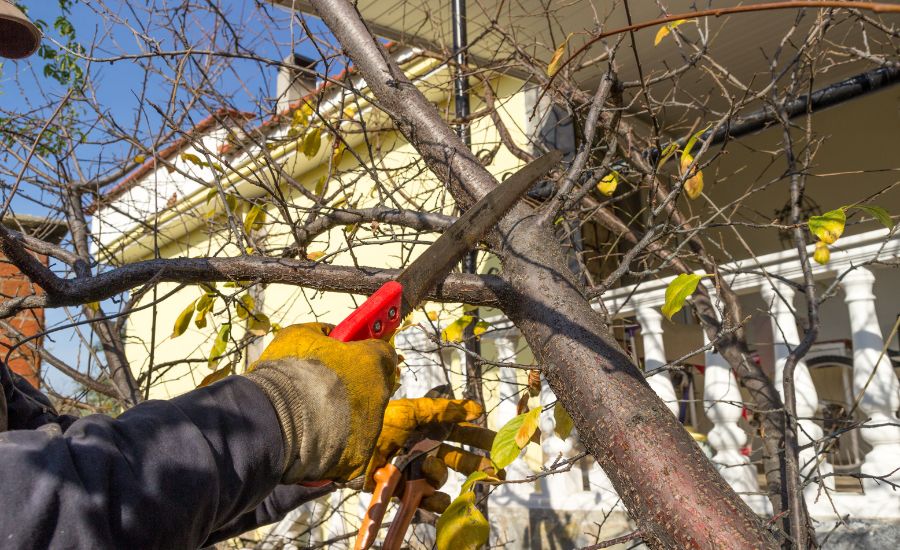Pruning for Prevention: The Importance of Deadwooding for Safe & Healthy Trees
Discover the dangers of deadwood, how to spot it, and why professional deadwooding is important. Protect your trees and property with B.G. Tree Care.
William Gambone
If you’ve ever looked up at the towering trees in your yard, you’ve probably noticed the lush green canopy of leaves. But have you ever taken a closer look at the branches? Some might seem brown, brittle, or even hollow. These seemingly insignificant branches are deadwood, and they can pose a serious threat to your tree’s health and the safety of those nearby.
Key Takeaways:
- Deadwood is a serious threat to tree health and safety.
- Deadwood is often caused by factors such as storms, disease, pests, and age.
- Removing deadwood is essential for maintaining the health and safety of your trees.
- Deadwooding should only be done by a certified arborist because they have the specialized knowledge and equipment to safely remove deadwood without harming the tree.

What Is Deadwood?
Deadwood is a term used to describe branches or portions of a tree that are no longer alive. It can appear in various forms, from thing, brittle twigs to larger, hollowed-out limbs. Deadwood often forms as a result of multiple factors, including:
- Storms: High winds, hail, and lightning can cause physical damage to trees.
- Pruning: Improper or excessive pruning techniques can stress a tree and contribute to deadwood development.
- Accidents: Collisions with vehicles, equipment, or other objects can cause injuries a tree can’t recover from.
- Disease: Certain tree diseases can weaken or kill branches.
- Pest Infestations: Insects and other pests can damage trees.
- Age: As trees age, their natural decline can result in the development of deadwood. Older trees may also have weaker branches that are more susceptible to damage and disease.
Why Is Deadwood Dangerous?
While it’s true that trees naturally shed branches and leaves as part of their growth and renewal processes, it’s important to understand the dangers it poses, including:
- Safety Hazards: Deadwood branches are prone to breaking and falling unexpectedly, especially during inclement weather or high winds, potentially causing injury or damage to your property.
- Structural Integrity: The presence of deadwood can compromise the structural stability of the tree. Weakened branches are more likely to break during storms, exposing the heartwood and eventually leading to further decay and potential collapse.
How Is Deadwooding Done?
Deadwood removal requires the skills and expertise of a Certified Arborist. Here’s how B.G. Tree Care handles deadwood removal:
Assessment
An arborist will carefully inspect the tree to identify deadwood. They’ll look for signs such as discoloration, brittleness, and cavities. The arborist will also evaluate the risk posed by the deadwood, considering factors such as the size of the deadwood, its location on the tree, and proximity to structures or people.
Planning and Preparation
Before beginning the removal process, an arborist will develop a safety plan to minimize potential risks. This may involve clearing the area around the tree, using appropriate safety equipment, and taking precautions to prevent damage to your property. The arborist will also select the appropriate tools and equipment for the job based on the size and location of the deadwood.
Removal Process
Once an arborist has completed their assessment and planning, they can begin the removal process. This may involve climbing the tree to reach the deadwood and using different pieces of equipment such as:
- Pruning Saws: These handheld saws cut smaller branches and twigs.
- Chainsaws: Chainsaws cut larger branches and limbs.
- Pole Saws: Pole saws are extendable saws that allow an arborist to reach high branches without climbing.
- Winches and Pulleys: These tools can help lift heavy branches and lower them to the ground.
- Climbing Gear: Arborists use climbing gear, such as harnesses and ropes, to safely access the tree’s canopy.
With the appropriate equipment, an arborist can carefully cut away the deadwood, taking care to avoid damaging healthy branches or the tree’s trunk. The removed material will be lowered to the ground for disposal.
Cleanup
Once the deadwood has been removed, all branches, twigs, leaves, and other debris will be carefully collected and processed in a woodchipper. If desired, the wood chips can be left on the property for mulch to enhance your landscaping. Otherwise, all tree debris will be removed and disposed of properly.
Can I Remove Deadwood Myself?
While it might seem tempting to try and remove deadwood yourself, hiring a Certified Arborist is strongly recommended. Arborists have the specialized knowledge and equipment to safely and effectively remove deadwood without harming the tree. They can also assess the overall health of your tree and provide recommendations for ongoing care.
Attempting to remove deadwood yourself can be dangerous, especially if you don’t have the proper training or equipment.
You could risk injury to yourself or damage to the tree. Additionally, improper removal techniques can weaken the tree’s structure and make it more susceptible to further damage.
B.G. Tree Care – Protecting Your Trees and Property Since 1998
Don’t wait until a disaster strikes before you take action to protect your trees and property. B.G. Tree Care offers expert tree care services, including deadwood removal, pruning, and tree health assessments.
Call us today at 484-941-4232 to schedule a consultation.

William Gambone
With almost 40 years of success in the tree care industry, it is evident that Bill’s passion extends beyond just the trees. He takes great pride in building relationships within the community, making B.G.






